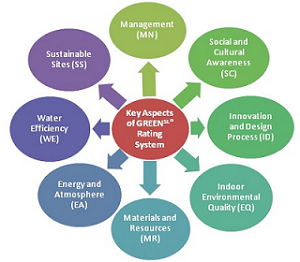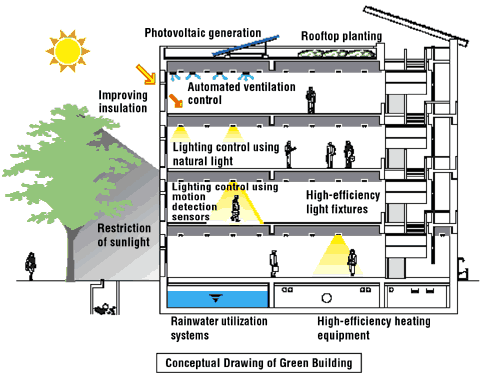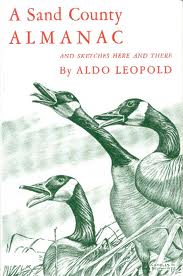Aldo Leopold’s ‘Land Ethic’ defines the relationship between people and nature, and simply enlarges the boundaries of the community to include soil, water, plants and animals, or collectively: the land. Instead of regarding it as a commodity belonging to us, we need to see land as a community to which we belong.
This paper tells us how we can integrate these 'land ethic' principles into planning and construction of green buildings.
This dissertation - ‘Recommending a set of guidelines for a green community development following the roadmap of The Land Ethic’, by Jatina Thakkar and Vinit Mirkar, deals with the following 3 main ideas:
Understanding the principles of “The Land Ethic”, using the book ‘A sand county almanac ‘ by Aldo Leopold
- Land is a community
- Land is to be loved and respected
- Land yields a cultural harvest
The three biotic elements – soil, water and plants and animals, need man to extend ethical behaviour to them. The ecosystem provides us with numerous services like :
- Provisioning services: Food, fibre, fuel, water
- Regulating services: Air quality regulation, climate regulation, water regulation
- Cultural services: Cultural diversity, spiritual and religious values, knowledge systems - traditional and formal
- Supporting services: Soil formation, photosynthesis, water cycle
Analysing the 3 existing green rating systems for community development, in relation to Land Ethic principles and ecosystem services
Green building is the practice of increasing the efficiency with which buildings use resources, namely energy, water and materials — thereby reducing a building’s impact on human health and the environment. Thus green building rating systems, are one of the tools used to show or evaluate concern for the environment including land.

Key aspects for green rating system for buildings giving weightage to various factors ( Source: srilankagbc.org)
The green rating systems have over time scaled up from building level to community level and 3 main systems are discussed:
- BREEAM (Building Research Establishment Environmental Assessment Method), based in UK is the world's foremost environmental assessment method and rating system for buildings. Weightage is given on diverse categories such as governance, social and economic well-being, land use and ecology
- PEARL Rating System for ESTIDAMA - Estidama, which means ‘sustainability’ in Arabic, aims to address the sustainability of a given development throughout its lifecycle. It is organized into seven categories that are fundamental to sustainable development like integrated development processes, natural systems, precious water etc.
- IGBC Green Townships Rating System, is a tool which enables the designer to apply green concepts and criteria, so as to reduce environmental impacts that are measurable. It is designed to address large development projects and it is mandatory to include residential development as part of the township. Out of the total 40 assessment issues under IGBC, only 26 have been considered suitable for the Land Ethic assessment.
Finally a comparison of the three rating systems on basis of their respective issues and credit points is detailed. This analysis helps derive an understanding about the issues, sub-issues and significance given to each issue in terms of credit points dealt within each system. Comparing the three systems above, it is observed that:
- IGBC involves a lesser number of issues (hence, less overall effort), but fetches more credit points comparatively
- BREAM is almost equivalent to IGBC in terms of both paramaters - issues and credit points
- PEARL demands more issue compliance (hence, more overall effort) but less credit points as compared to those achieved in IGBC. This means Pearl Rating Systems are comparatively more arduous to achieve
Recommending a set of green guidelines for community development on basis of Land Ethic principles
The author chooses certain keywords like community, land health, land organism, ecological conscience etc, based on which a land ethic model has been proposed, where man is the key member. A comparison between the three rating systems is carried out. For example for the Land Ethic keyword ‘water’, BREAM scores the highest in effort percentage, and PEARL the highest in credit points percentage.

Conceptual design of a green building (Source: Ecomena)
After a comparison of three varied types of rating systems for community development, guidelines are formulated underpinning the principles of the Land Ethic in terms of soil, water and plants. Some of these in random order are:
- Understand and identify those ecological aspects of the property that contribute to the land as an organism
- Understand and identify the symptoms or indicators of a healthy ecosystem, including land
- Identify the components that will contribute to land pyramid and cycle
- Identify existing pollution level or future probability of pollution of water
- Identify the water and fertility requirement for the normal growth and survival of the plants
- Identify strategies and methods for rainwater harvesting
- Identify benefits from ecosystem services on the property and in the surrounding area
- Conserve the natural water bodies and natural water sources present on the property
An illustration of Community Development Guidelines recommended on basis of Land Ethic keywords are:
Water
Collecting rooftop water and grey water (from households) to be diverted to a central reed bed system. The treated water to be used:
- For plantations along the road side
- As a water body with evaporative cooling to reduce heat island effect
Soils
Considering the treatment of waste and production of food in the following ways:
- Allocating a common garbage collection area along with a simple composting system or mechanism within the same place
- Allocating a common area for food production to serve the designated community
Plants
Creating intermediate community green belts within each community on the basis of the following calculations:
- Out of the 10% mandatory recreational open space, allocate at least 2% to 4% of the area for the purpose of green belts within each plot. The remainder open space may be proposed as per architectural design (the percentage allocation may depend upon the size of the plot)
- Create such green belts comprising of atleast 5 m in effective width
An understanding and use of Land Ethic keywords such as – land health, land organism and so on, will enable development to be more sensitive and vigilant to the modifications that it causes to the land. All development needs to be associated with the ecosystem services that are either hampered, terminated and enhanced at every stage of development process so that the ‘Land Ethic’ becomes a part of all green development.
To read the full dissertation, please download the attached PDF.
About the authors
Jatina R Thakkar is an architect from L. S. Raheja School of Architecture, Mumbai, working for the last 11 years, primarily in the residential sector. This research report is a dissertation she did as part of a course in Environmental Architecture, from IES College of Architecture, Mumbai.
Vinit Mirkar is a core faculty and technical head for the B Arch, and the HoD for M Arch in Environmental Architecture courses at at IES College of Architecture, Mumbai. He has done his PGD in Environmental Architecture from Rachana Sansad, Mumbai. He is currently pursuing his PhD in reinterpreting sustainable architectural strategies, theories and practices for upcoming urban settlements in coastal Maharashtra.
